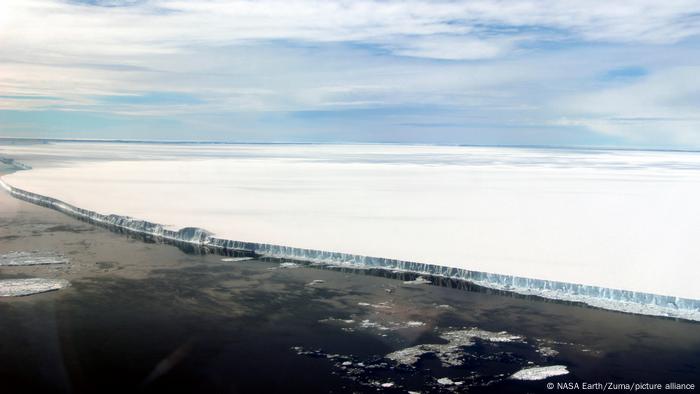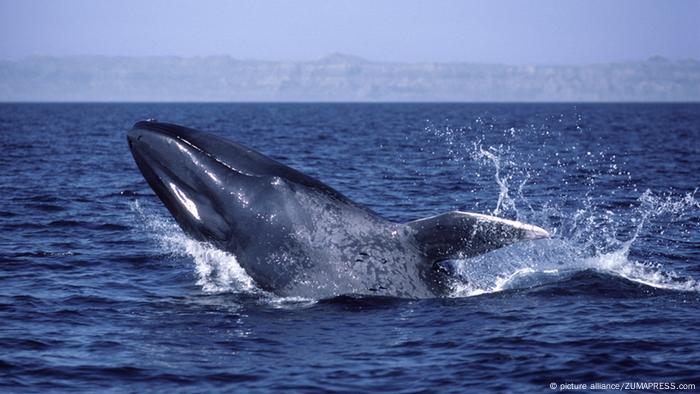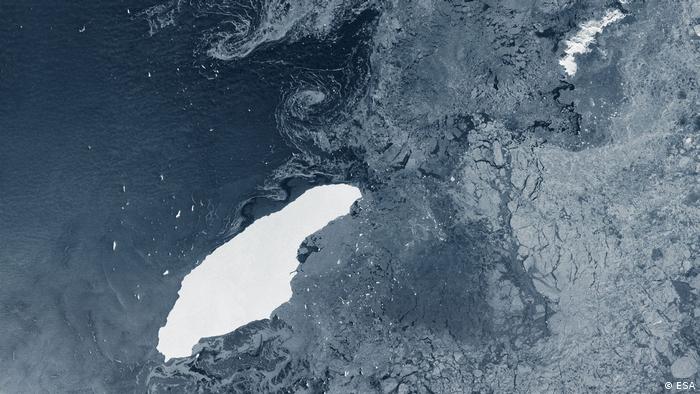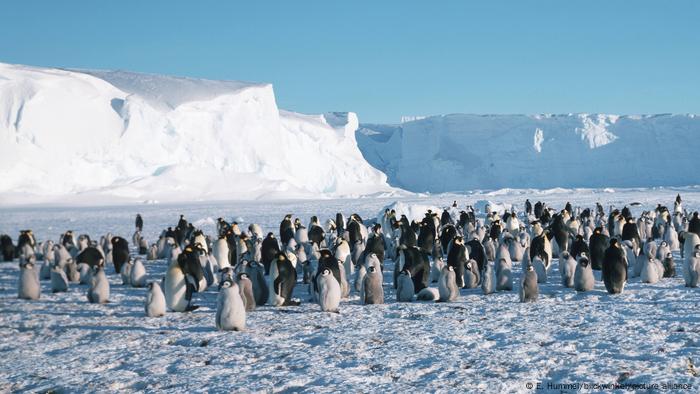Giant iceberg starts to break up in the South Atlantic
The #A68a iceberg has been on a potential collision course with the British overseas territory of South Georgia for some weeks. Researchers are concerned about its impact as it starts to break up

The massive A-68A iceberg has been drifting toward South Georgia for several weeks
There is growing concern over a collosal iceberg on a collision course with the British territory of South Georgia, a largely uninhabited South Atlantic island of roughly the same size.
Measuring 158 kilometers long (98 miles) and 48 kilometers wide, A68a — as the iceberg is called — is believed to be the biggest currently in the southern ocean, and one of the largest on record.
As the iceberg has moved closer to the island over the past weeks, aerial images have shown it breaking up. This has sparked concern over the impact of freshwater from the melting ice on local marine life.
"This is basically an area that's completely thriving with wildlife," Geraint Tarling, a professor with the British Antarctic Survey (BAS), told DW. "The island has globally significant populations of penguins and seals ... Enormous numbers that if they were not there anymore, there would be severe declines in quite a few species."
Scientists are due to set off for the region next month on the research ship RRS James Cook to assess the impact on local biodiversity. The waters around the island are home to recovering populations of humpback and blue whales. South Georgia is also home to one of the largest numbers of albatrosses in the world.
Two underwater robotic gliders will be used to get as close to the iceberg as possible to measure water temperature, salinity and plankton concentrations.

The waters around South Georgia are home to species such as the humpback (above) and the blue whale
'Iceberg graveyard'
Scientists had expected A68a to shatter after breaking off from the Larsen C ice shelf on the east coast of the Antarctic peninsula in summer 2017.
According to the European Space Agency (ESA), the icy giant has lost at least two large chunks during its long journey, prior to which it was roughly twice the size of Luxembourg.
Although A68a would be the biggest to hit the island, it would not be the first in the region named the "iceberg graveyard." In 2004, a smaller iceberg grounded a few kilometers from land.
What is particularly concerning about this one is not only its size but its shallow shape, explained Tarling. According to ESA, the iceberg is only a few hundred meters thick.

The iceberg has been at sea since calving from the Larsen C ice shelf in July 2017
"This one has the potential to go right on the shore and really block those [animal] colonies from getting to their food sources and coming back to get the food back to their pups and chicks.”
In addition to preventing access to foraging paths to offshore food sources for penguins, seals and albatrosses, it could also disrupt conditions for marine algae at the base of the food chain, said Tarling. "And if that's not there, then everything that depends on it can't thrive either.”
The iceberg could also impact creatures on the ocean's floor, he added, many of which store carbon in their bodies and secure it in the seabed. "If this is scoured, it gets churned up, it goes back into the water column and then goes back into the atmosphere potentially.”

South Georgia is home to huge colonies of penguins as well as albatrosses that could be adversely affected by the iceberg
Currents will decide iceberg's path
While still traveling through the water, icebergs of A68a's size can also have a positive environmental impact through the meltwater they produce, said Grant Bigg, professor in earth systems science at the University of Sheffield in northern England.
Bigg said the icebergs can release plumes of material, sometimes hundreds of kilometres long, which contain iron, picked up while the ice moved over land before reaching the ice shelf. This can fertilize the ocean and support organisms such as phytoplankton.
If the iceberg, which has already traveled an estimated 1,600 kilometers, continues on a direct trajectory at its current speed of one kilometer per hour, BAS predict it could arrive at the island between late December and early January.
"It's too large to really do anything about it," said Bigg. "It's a case of waiting and seeing, and hoping the currents will send it around the south [of the island] or break it up."

FASCINATING ANTARCTICA: ICY FACTS ABOUT THE MOST SOUTHERN REGION IN THE WORLD
99 percent ice
Antarctica is the largest desert in the world, covering an area of 13,829,430 square kilometres (533, 957 square miles) — about 1.3 times the size of Europe. Even in the Antarctic summer, from December to February, 99 percent of Antarctica is covered with ice, some of it up to 5000 meters thick.
PHOTOS
123456
DW RECOMMENDS
Huge iceberg breaks off Antarctica
A block of ice more than 1,500 square kilometers in area has broken off the Amery Ice Shelf in Antarctica. But researchers say the production of this iceberg, called D28, is not due to climate change.
Antarctica's Larsen C ice shelf: new rift detected
Where a trillion-ton iceberg calved last week, researchers have detected a new rift. The concern is that the Larsen C ice shelf will destabilize and collapse, releasing glacial ice into the sea.
No comments:
Post a Comment